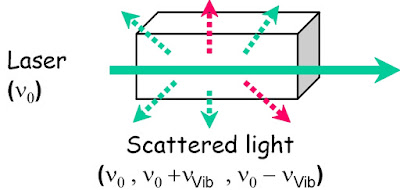Posted on February 28, 2016
I like referring to him as “C.V.” because his full name is Chandrasekhara Venkata Raman. Which is a lot to type.
On the other hand, like Charles Darwin and Albert Einstein, at least spell check know's Raman's full name and didn't allow me to accidentally type something like Chardrasekhara or Chandrasakhara or....whatever else my flying fingers blundered out.
And since 1929, Raman's full name ALSO included “Sir,” because he was knighted by Britain.
So, why am I bringing up Sir Chandrasekhara Venkata Raman today? Just because he was an Indian scientist and today is National Science Day in India?
Actually, it is because of Raman that today was chosen to celebrate and promote science in India – because today is the anniversary of his most important, Nobel-Prize-worthy discovery: the Raman effect.
So...what's the Raman effect?
You probably know that visible light is a form of electromagnetic radiation, along with infrared, microwaves, X-rays, radio waves, and ultra-violet light. All electromagnetic radiation travels in little “packets” called photons.
I bet you have heard that, on a clear day, the sky looks blue because of scattering. But what is being scattered by what?
Air is not empty space – it's full of lots of different particles and molecules, most of which are invisible to us. When light from the Sun hits particles or molecules, some of the photons's paths are disrupted, and the various photons scatter about randomly. And blue photons have the tiniest wavelengths of all visible light, so they tend to get scattered more than green or yellow photons, and especially more than orange or red photons.
This is called Raleigh scattering, or elastic scattering. The photons that scatter shoot off on other, random paths, but they don't change their frequency and wavelength. In other words, a photon of blue light stays a photon of blue light.
In 1923, a physicist predicted that a few photons would scatter in another way. They would scatter by excitation – in other words, they would change frequency and wavelength, either gaining or losing energy. A photon of blue light might become a photon of red, or vice versa.
On this date in 1928, Raman and K. S. Krishnan discovered the predicted behavior. Only about one photon in 10 million changes wavelength as it scatters, but they were able to observe it as light passed through a liquid.
(Actually, two Soviet scientists discovered this same sort of scattering as light traveled through crystals about a week before Raman and Krishnan's discovery! The reason that the “effect” is named after Raman – and the reason that Raman and Krishnan share a Nobel Prize for the discovery – is that the Indian scientists published their findings before the Russian scientists did.)
 In 1928, the Raman effect seemed important to scientists, especially those in the field of spectroscopy (the study of light that has been emitted from, reflected from, or shone through a gas, liquid, or solid). But I don't know that the Raman effect had much...um...effect on the rest of us. However, these days there are a lot of utilities in many different fields. Here's a practical one: a Raman scanner is a hand held device used to detect drugs, explosives, hazardous chemicals, gases, and so forth. It is used by narcotics squads, airport security, forensic detectives, and security experts.
In 1928, the Raman effect seemed important to scientists, especially those in the field of spectroscopy (the study of light that has been emitted from, reflected from, or shone through a gas, liquid, or solid). But I don't know that the Raman effect had much...um...effect on the rest of us. However, these days there are a lot of utilities in many different fields. Here's a practical one: a Raman scanner is a hand held device used to detect drugs, explosives, hazardous chemicals, gases, and so forth. It is used by narcotics squads, airport security, forensic detectives, and security experts.For more...
Check out this articleon other Indian scientists.
Also on this date:
Plan ahead:
Check out my Pinterest boards for:
And here are my Pinterest boards for:














